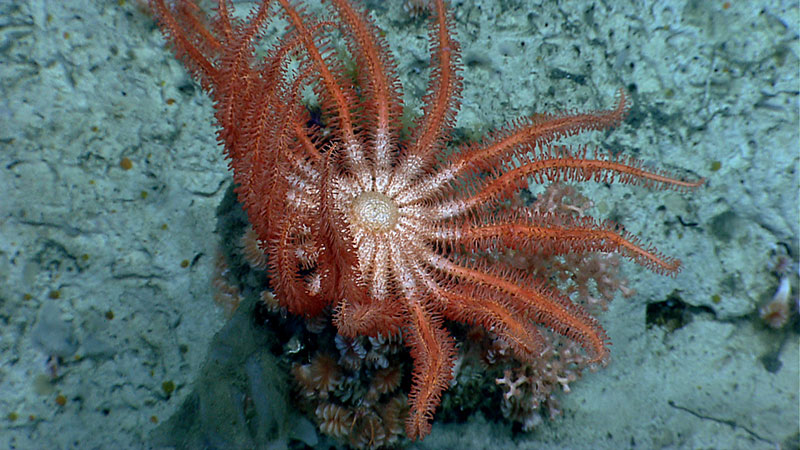
A brisingid sea star rests on a group of cup corals in Alvin Canyon. Image courtesy of the NOAA Office of Ocean Exploration and Research, Northeast U.S. Canyons Expedition 2013. Download larger version (jpg, 1.4 MB).

A brisingid sea star rests on a group of cup corals in Alvin Canyon. Image courtesy of the NOAA Office of Ocean Exploration and Research, Northeast U.S. Canyons Expedition 2013. Download larger version (jpg, 1.4 MB).
Video highlights from Dive 11 to explore the geomorphology and benthic habitats of Block Canyon. Remotely operated vehicle Deep Discoverer descended to a soft bottom seafloor with scattered rock rubble and boulders and an abundance of red crabs and cutthroat eels along the eastern wall at a depth 1,340 meters. Video courtesy of the NOAA Office of Ocean Exploration and Research, Northeast U.S. Canyons Expedition 2013. Download video (mp4, 41.7 MB).
Dive 11 of the Northeast U.S. Canyons 2013 Expedition explored the geomorphology and benthic habitats of Block Canyon. Remotely operated vehicle Deep Discoverer (ROV D2) descended to a soft bottom seafloor with scattered rock rubble and boulders and an abundance of red crabs and cutthroat eels along the eastern wall at a depth 1,340 meters. Flytrap anemones, hydroids, bamboo corals, and octocorals were attached to the rocks, with many being small recruits. Potential new species of black coral and bubblegum coral were observed. An oreo fish (first of this cruise) was documented at a depth of 1,345 meters. D2 moved upslope to a promontory feature hosting a high abundance of coral rubble. Dense and diverse sponge and coral communities with numerous species of bamboo corals, cup corals, and large black coral were growing on the wall as we ascended to the top of the feature. Small horizontal cracks in the wall were evident. D2 then came back down slope to a depth of 1,335 meters to begin the next vertical transit. At the base, coral rubble was dense and two more oreo fish were observed. The ROV moved upslope, noting similar corals in high abundance and numerous squat lobsters, shrimps, and brittle star associates en route to the top of the wall at 1,239 meters. Of note, chirostylid squat lobsters were only observed living on black corals. At least one skate egg case was observed during this dive. Hard substrate in this area was visually similar to those in both Alvin and Atlantis Canyons and all are possibly in the same age range (Cretaceous/Eocene).